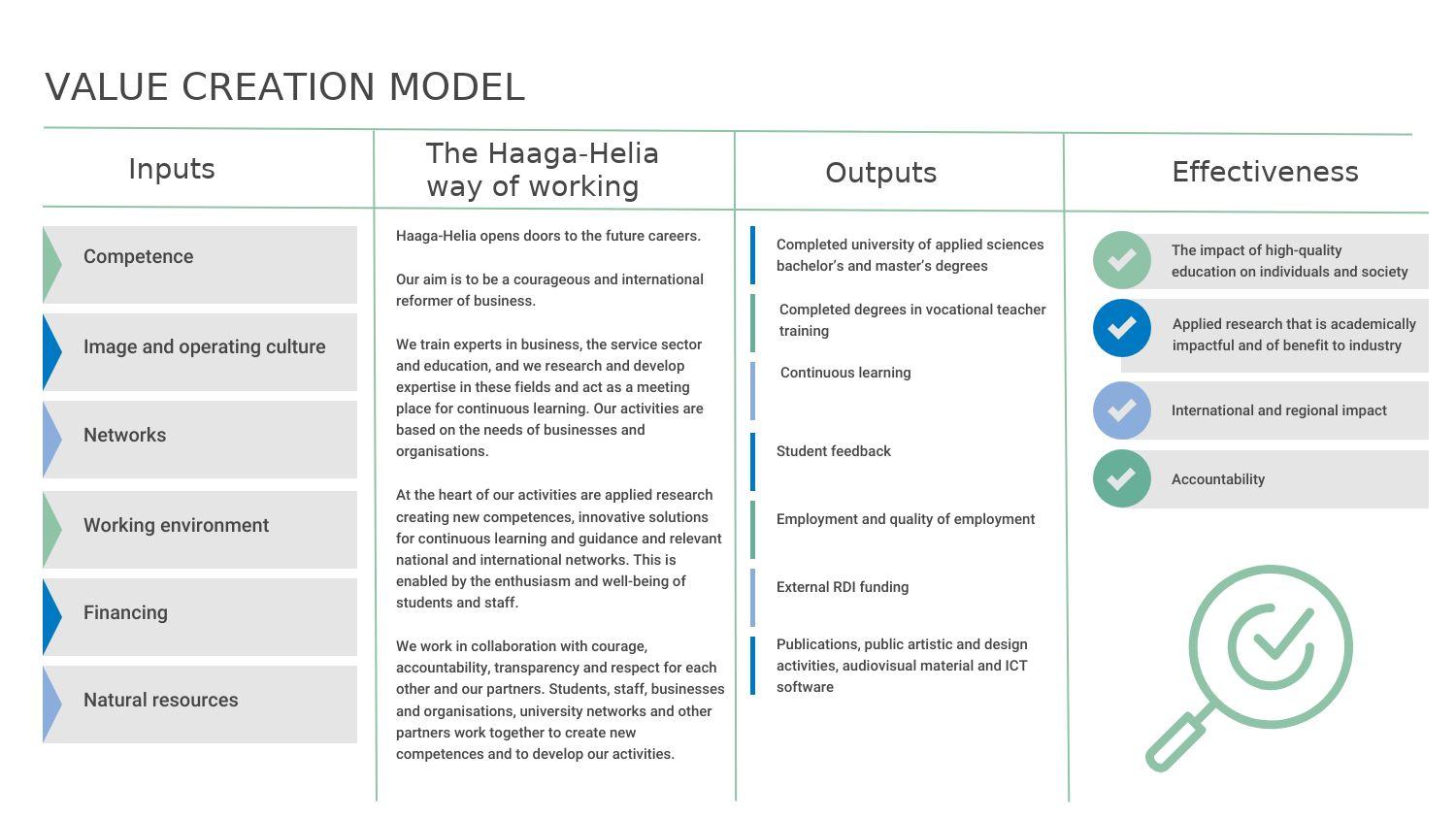Haaga-Helia has established procedures to set the direction of its activities
Haaga-Helia has established a clear strategy and operational guidelines for managing societal engagement and impact. They have also implemented management instruments and procedures to identify RDI developments and to extract the needs of external stakeholders. To ensure the strategy is up to date, Haaga-Helia regularly engages in systematic dialogue with external stakeholders, including an annual Future Forum for stakeholders and staff. Furthermore, advisory boards have been set up for different sections and an international advisory board is said to be established in the near future. The international advisory board should provide guidance in order to focus and prioritize the engagement of Haaga-Helia in their international networks and activities.
Governance has been optimized in order to ensure that societal engagement supports the overall strategy
The management of societal impact at Haaga-Helia was initially the responsibility of one person. However, due to the complexity of coordinating RDI activities across multiple fields, this responsibility has since been distributed among several members of Haaga-Helia’s management team. This change is expected to have significant advantages, given the multidisciplinary nature of societal impact. Nonetheless, the management group within Haaga-Helia must ensure regular and efficient cooperation and communication among themselves and with relevant sub-sections. In the interviews, it became clear that internal communication has been identified as a major challenge within all status groups of Haaga-Helia.
The objectives of Haaga-Helia’s societal impact are included in its 5-year strategy plan and evaluated and adopted annually. Haaga-Helia has defined a value creation model that should monitor and evaluate societal impact from four perspectives. The qualitative success criteria (“Outputs”) as defined in Picture 17 in the self-assessment report are reasonable criteria, since these are the typical outputs of universities of applied sciences.
Both qualitative and quantitative success criteria have been defined by Haaga-Helia
Haaga-Helia has defined yearly quantitative criteria and objectives for the follow-up of the societal impact, such as number of graduates, amount of RDI funding or number of refereed articles. These criteria and objectives have been integrated into Haaga Helia’s normal key performance indicators and they are part of the strategy map and yearly action plans, which have been published in the intranet for staff and students. They have been monitored systematically throughout the current year by groups, responsibility areas and management group. They are updated yearly as a part of the strategy map and action plan. They have also been integrated in the strategy tool and PowerBI for systematic follow-up and openness.
According to the interviews, both principal teachers and senior researchers at Haaga-Helia are highly and intrinsically motivated to carry out RDI projects. The external stakeholders also confirmed and praised Haaga-Helia’s business and application-oriented approach in the interviews, both as an institution and regarding its staff members.
Haaga-Helia systematically follows a business and application-oriented approach and enhances societal impact through teaching and RDI activities
In the interview, the board appreciated the way in which its views have been taken into account, for example, in connection with the reorganization of Haaga-Helia’s internal structure. The board members have identified the existence of many silos within Haaga-Helia as a primary challenge and have suggested that the majority of staff members be given the opportunity to participate in RDI projects since currently, only 39% of the teachers and 25% of the support staff are involved in them.
The vast majority of teaching and RDI staff members have a practical background, which is essential for a university of applied sciences such as Haaga-Helia. According to the interviewees, approximately 80% of all students work in parallel to their studies. This already creates substantial societal impact, assuming that most of the students work in the area of their studies. According to Haaga-Helia more than 600 companies are involved in joint RDI activities. This is a very high number creating substantial societal impact in the region. The majority of RDI projects are externally funded, i.e. funded by public funding sources (competitive funding) as well as by the private sector. In addition, a large number of projects were carried out in the framework of Haaga-Helia’s degree programmes, e.g. during the thesis phase.
